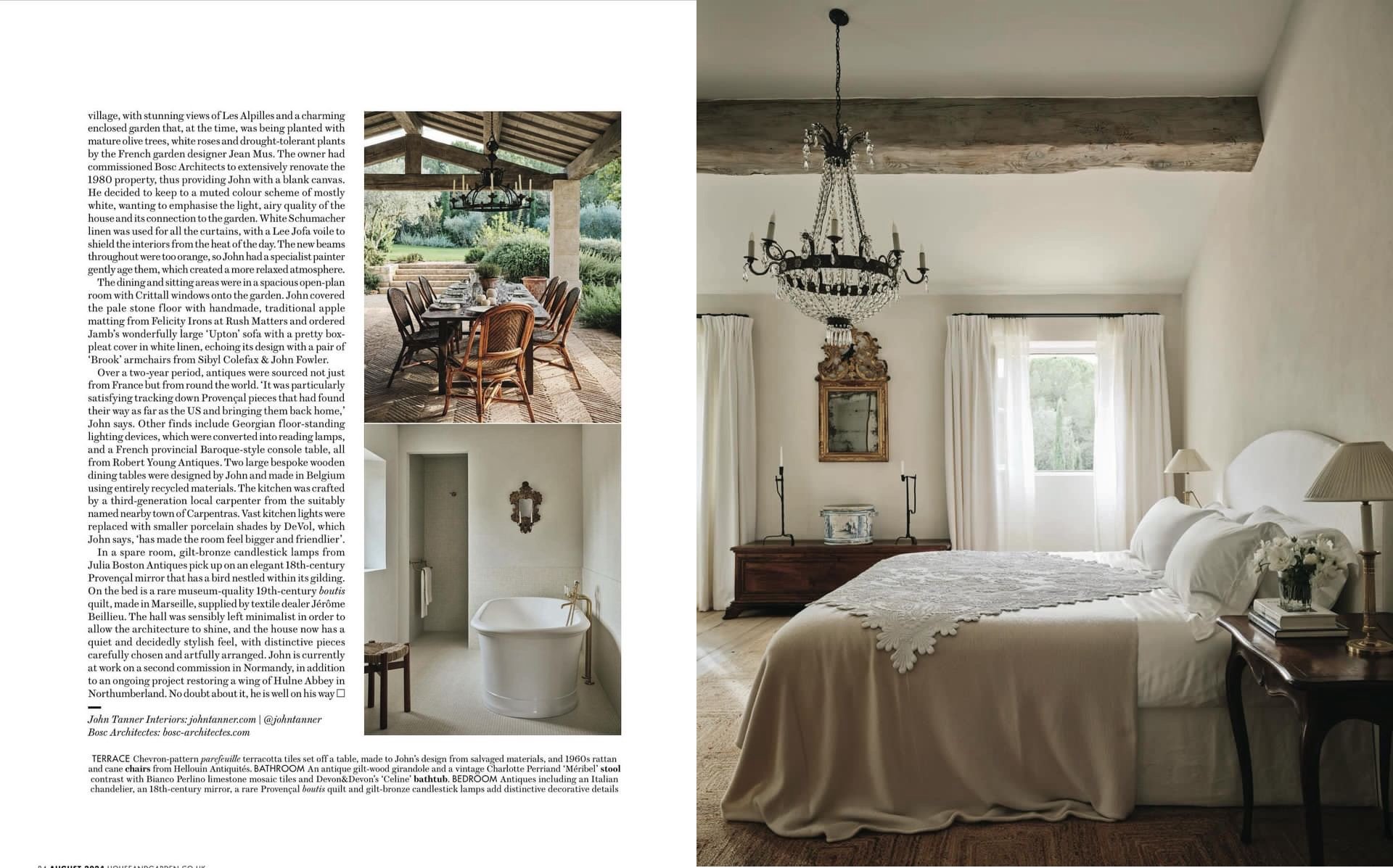Natural Flair
Though relatively new to interior design, John Tanner has long had an eye for the beautiful and eye-catching. In this Provencal house, he has mixed carefully chosen vernacular antiques with a neautral colour palette and natural materials for a quiet, considered look.
John Tanner is the first to admit that he has come to the world of interior design by an unusual route, having started his professional life as a skateboarder. From the ages of 15 to 21, he travelled the world, skating for sponsors and filmmakers. His passion for collecting developed during these trips, gradually diversifying from vintage skateboards to other objects that he considered beautiful and caught his eye.
Eventually, he realised this obsession with collecting and his love of design should become the greater part of his life. After a period working at The Conran Shop during Jasper Conran’s reign, he, along with his partner Richard Swallow - a broadcaster who has since returned to his first love of art - opened a gallery on Columbia Road, E2, displaying Richard’s paintings alongside an interesting curation of objects and furniture.
Unable to find the right house in London, the couple moved to North Norfolk - where they both have family connections - and renovated a gardener’s bothy on the Gunton Park estate. Nearby, art dealer and collector Ivor Braka's inn, The Gunton Arms, had just been decorated by Robert Kime and, down the road, Peter Sheppard and Keith Day were restoring Horatio Walpole’s Palladian masterpiece Wolterton Hall (featured in House & Garden’s February 2023 issue). Having these neighbours as points of reference served as a perfect background from which John could further develop his own distinctive style.
When eventually his beautifully decorated cottage in Gunton was bought by Ivor, John’s life took another turn, as he and Richard began a new project renovating a house in Cotignac, in southern France. Visiting brocantes to source antiques for their new home, John was completely in his element. Then, with his own website set up, he was delighted to receive a call from a Toronto-based businesswoman, who had bought a house in Provence and wondered if he might decorate it for her.
She could see from his Instagram account he had a good eye and that ‘having a base in the south of France meant I was able to spend lots of time sourcing antiques’, says John.
She felt he was young, energetic and would be able to give the project the attention it required. Phone conversations confirmed their compatibility and a mutual love of fabrics and antiques, and, soon after, they embarked on the first of many buying trips together in L’Isle sur la Sorgue.
The house is within walking distance of a picturesque village, with stunning views of Les Alpilles and a charming enclosed garden that, at the time, was being planted with mature olive trees, white roses and drought-tolerant plants by the French garden designer Jean Mus. The owner had commissioned Bose Architects to extensively renovate the 1980’s property, thus providing John with a blank canvas.
He decided to keep to a muted colour scheme of mostly white, wanting to emphasise the light, airy quality of the house and its connection to the garden. White Schumacher linen was used for all the curtains, with a Lee Jofa voile to shield the interiors from the heat of the day. The new beams throughout were too orange, so John had a specialist painter gently age them, which created a more relaxed atmosphere.
The dining and sitting areas were in a spacious open-plan room with Crittall windows onto the garden. John covered the pale stone floor with handmade, traditional apple matting from Felicity Irons at Rush Matters and ordered Jamb’s wonderfully large ‘Upton’ sofa with a pretty box-pleat cover in white linen, echoing its design with a pair of ‘Brook’ armchairs from Sibyl Colefax & John Fowler.
Over a two-year period, antiques were sourced not just from France but from round the world. ‘It was particularly satisfying tracking down Provençal pieces that had found their way as far as the US and bringing them back home,’ John says. Other finds include Georgian floor-standing lighting devices, which were converted into reading lamps, and a French provincial Baroque-style console table, all from Robert Young Antiques. Two large bespoke wooden dining tables were designed by John and made in Belgium using entirely recycled materials. The kitchen was crafted by a third-generation local carpenter from the suitably named nearby town of Carpentras. Vast kitchen lights were replaced with smaller porcelain shades by DeVol, which John says, ‘has made the room feel bigger and friendlier’.
In a spare room, gilt-bronze candlestick lamps from Julia Boston Antiques pick up on an elegant 18th-century Provençal mirror that has a bird nestled within its gilding. On the bed is a rare museum-quality 19th-century boutis quilt, made in Marseille, supplied by textile dealer Jérôme Beillieu. The hall was sensibly left minimalist in order to allow the architecture to shine, and the house now has a quiet and decidedly stylish feel, with distinctive pieces carefully chosen and artfully arranged.
John is currently at work on a second commission in Normandy, in addition to an ongoing project restoring a wing of Hulne Abbey in Northumberland. No doubt about it, he is well on his way.
- House & Garden, August 2024




